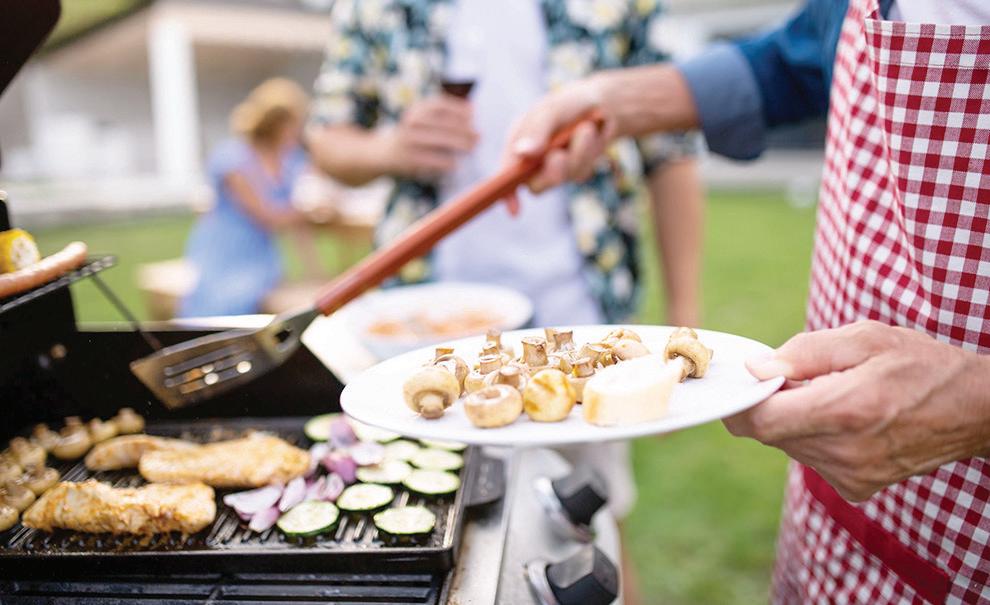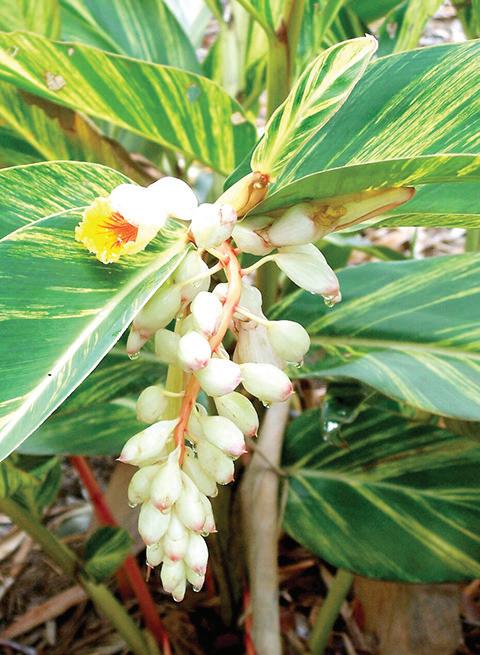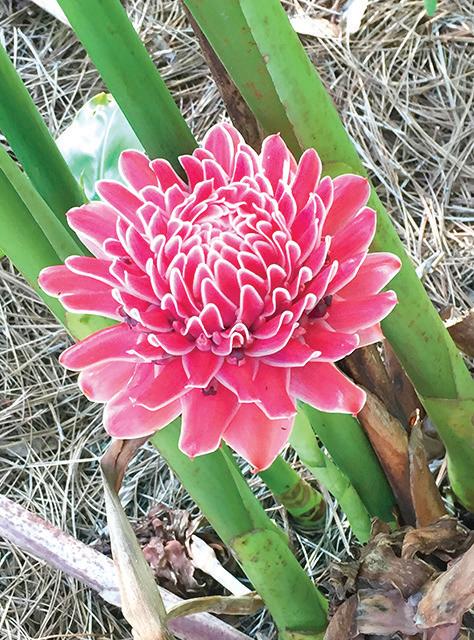

The Club At Gateway
Golf Tip From Gyles …
Want to be a better chipper?
There are some very important fundamentals when you are chipping. Use these fundamentals while practicing to improve in minutes.

Gyles Robin
Choose the club you want to use by imagining the shot you want to hit. If it’s a higher shot you need more loft. If it’s a lower running shot you need less loft. One of the most important parts of chipping is deciding where you want the ball to land. All the best players in the world are looking at the point they want to land the ball because they have decided how they think the ball will roll after it lands.
Make sure you preset your weight 60 percent on your leg closest to the target at address. If you do this correctly it will lock your lower body so your upper body can control the swing.
With your weight 60 percent on your left, make sure the end of the grip is pointing at your belt buckle and your ball position is just in front of the middle of your stance. (Your hands should be ahead of the ball). *If you want to hit a lower chip shot you can move the ball back in your stance.
To control the tempo of your swing and, therefore, the distance of your shots, try and make the club head travel as far back as it goes through.
Make sure you accelerate the club through impact (this can be scary for some people). If you have the correct fundamentals this won’t be as scary because you will create
spin and ultimately have more control of the golf ball. When these fundamentals are correct you will make the club bounce into the ball and brush the top of the grass.
In this tip, I didn’t mention anything about opening stance or adding loft to your club. These are used for different shots, not a basic chip shot. If you would like to learn more about different types of chip shots and the techniques we use to hit them, please contact me at golfpro@gatewaygcc.com or go onto Foretees to book a lesson.
Personal Training With Mary Margaret
Pictured below is a training session with Mary Margaret Tarutis and Judy Sentimore. Judy is a beautiful soul and has been training with Mary Margaret for about a year

Gateway Women’s Club
By Janice Eaton, Laurel Borgia, Marianne Kollasch and Donna Marchetti
Gateway Women’s Club Takes A Close Look At Wine Pairing
By Stephanie K. Mena
Sarah Yanovich, food and beverage director of The Club at Gateway, took time from her busy schedule and spoke to the ladies of Gateway Women’s Club (GWC) on this mystifying topic.
Planning the right meal to prepare for your holiday party, birthday celebration, or even a quiet dinner with friends is challenging enough. Deciding which wine to serve complicates the decision even more. Yanovich offered a simple solution, “Drink what you like, but always be willing to explore your boundaries.”
At the start, look at the center of the plate. What is the most dominant flavor? Don’t forget about the sauces. Flavor
balance is the key to great pairings. Light bodied white wines are high in acid, citrusy and refreshing. Sauvignon Blanc, Dry Riesling, Chablis, Pinot Grigio, Vermentino and Verdejo complement shellfish – oysters, shrimp, scallops and clams. Delicate white fish like grouper, snapper, flounder, cod and haddock are also great accompaniments. Oak Aged Chardonnay, Viognier, Soave and White Rioja are rich, creamy, oaky, toasty, lower in acidity and have riper fruit flavors. They blend well with lobster, crab, monkfish, skate, Chilean sea bass and swordfish.
Light bodied red wines bring higher acid, lower alcohol, and low tannin. Pinot Noir, Beaujolais, Nebbiolo, Zweigelt pair well with lean red meats like grilled fillet mignon, veal chops/ tenderloin, and lamb chops. Game meats and poultry also fit well including pork, duck, Cornish games hens and venison. Dark fleshed fishes /fattier seafood like tuna octopus, salmon, grilled or smoked fish are also included.
Heavier reds offer lower acid, higher alcohol and higher tannin. This group includes Cabernet Sauvignon, Merlot, Syrah, Zinfandel, Malbec, Tempranillo, and Red Blends. They
now. She has made great strides with strength, stamina, stability and balance. At her first session, she was unable to walk up the steps, and now one short year later, she has achieved all of her goals. Mary Margaret is available for personal training on Monday, Tuesday, Thursday and every other Saturday.

match well with roasted/braised red meats like ribeye, Osso Buco and short ribs. Also smoked/BBQ meats including pork ribs, beef brisket, pork belly, BBQ chicken and sausage. They stand up well to big flavors like lasagna, spaghetti Bolognese, beef stew and loaded burgers.
Yanovich ended her presentation with easy to play fun games. In the Brown Bag Blind Tasting Game, the host purchases three to five wines, places each one in a brown bag labeled with a number. The goal of the game is to identify the variety of each wine. A higher-level game asks you to identify producer and the vintage of each bottle.
Yanovich had an early start in the food industry working in hospitality at the young age of 13 beginning as a dishwasher and progressing to the front of the house in college. Sarah holds a bachelor’s degree in culinary arts business management from the Culinary Institute of America and a Level 2 Award in Wines from the Wine and Spirit Education Trust. She has a special interest in the production and creation of wine, the
Whispers Of God Family Bonds
By Dr. Mark P. Gonzales, Executive Director, Royal Palm Association of Churches, SBC
Years ago, I was in Beirut for a world missions conference where my Biblical view of family and family bonds were unexpectedly challenged—in a good way— that expanded my previously narrow assumptions.

It all started in a large breakout session led by the chair of family studies from a well-respected Bible college back in the United States, who casually opened with a greeting and an icebreaker.
“Thank you so much for coming. I’m so honored to facilitate this session, so why don’t we get started by breaking into groups of five or six people for about 10 minutes and simply make a list of all the different types of families we can think of that are represented in Scripture. Then we’ll come back together to blend all the lists and see how many we came up with.”
That will be short work, I thought. How many are there, seven, eight, nine? My group came up with 18! We were all stunned as the list grew in our group as we brainstormed together until time was called. Then the lists were merged
stories behind the products, wine regions and the families that grow and make the wine.
Yanovich first came to Gateway in 2015. In addition to her duties as the Food and Beverage Director at The Club at Gateway, Sarah oversees the Wine Club, maintains members’ personal wine storage and coordinates wine tasting events.
Book Club
The GWC Book Club will meet at Carol Ann Brown’s home Aug. 13 at 7 p.m. The co-hostess is Mary Jo Cornell. The group will be discussing the novel Killers of the Flower Moon by David Grann. The book discussion leaders will be Mary Mills and Lois Hyatt. Please let Carol know if you plan on attending by Aug. 11 at the latest. This novel depicts a true story about the serial murders of the Osage Nation in Oklahoma in the 1920s. Carol’s information can be found in the GWC Directory.
– Jan Hartzell
Sit And Stitch

and grew to a list of family types around the mid-20s! What?! Yup. Curious?
Well, first, Jesus grew up in a blended family with half-brothers and a stepdad! Then there were families with a husband and wife with no children, a single dad with kids, a single mom with kids, and blended families due to second marriages. Timothy seemed to be primarily raised by his mother and grandmother due to his largely absentee Greek father. Ruth found herself in a family with her mother-in-law and sister-in-law when each of their husbands progressively died. Esther was a family with her uncle who raised her when her parents died. Patriarchal or generational families living as one were not unusual. Grandparents raising children, racially mixed families, adopted children’s families and many more examples made up the list. And when it comes to a sense of “family bonds,” we can go beyond that and add the metaphor of
Broadway Palm Dinner Theater
A group from Gateway Women’s Club and friends enjoyed the wonderful production of Swing Swing is a combination of high energy dancing, singing and acrobatics with no dialogue in the show which is told entirely through music and dance.

Dining Out
the family of faith, or the sense of family in a local church, the workplace, on the mission field, in the military, in neighborhoods, communities, schools and universities, sports teams, or in survival scenarios, and more.
So, what’s my point with all of this? Well, a sense of close family bonds is not singularly determined by bloodline or traditional family structures. Yes, very often the bond of “blood is thicker than water” is very much in place, but other times bloodline family feuds can erupt and break that bond. And while it is best to do all you can to be reconciled, the good news is that the Lord has created many ways to feel a sense of family so that we do not have to feel abandoned and alone on this earth.
Life is unpredictable. All of us are broken. The future is unsure. The world is a mess. And there is evil out there. But our Heavenly Father has provided Himself, His Son, and all kinds of family options to bond with. How can we find it?
Well, look for three things: Humility, love and trust. When you see that kind of heart-fruit with some people near you, a sense of family bonding is not far away. Even with your bloodline family. Hard to do when you’ve locked yourself up in the chains of futile self-protection, but well worth the effort to experience the joy of better bonds with all kinds of family that are closer than you think.
Savoring family bonds with you, Pastor Mark
Articles, videos and podcasts: markpg.org. Write and share at mark@quillpress.org. Hear me every Saturday, 8 a.m. on 91.5 FM.
It recreates swing-style of jazz, large bands. Lindy
and Jitterbug were represented.


The next Sit and Stitch meeting will be hosted by Carol Warrell on Aug. 12 at 1 p.m. Please contact Carol if you plan to attend. Her information can be found in the GWC Directory. The group includes many GWC members working on different projects. The members are still working on projects for Hospice and scarves for college-attending students who were in foster care. Any GWC member is welcome to join.
– Eleanor Stuart
Bridge
Bridge 101 will meet Aug. 6 and 20 at Hampton Park Amenity Center at 10 a.m. Please contact Susie Kravetz by phone or email (her information is in the directory) to let her know if you are attending. The group needs a number count and names of attendees to get through the front gate. They welcome anyone who plays bridge.

– Laurel Borgia

The Gateway Women’s Club Dining Out group recently ventured to Courtney’s Continental Cuisine located on Summerlin in Fort Myers. Not showing any signs of slowing even during off season and undeterred by the heat, the group of 24 are proof of its mantra that “the best memories are made around the dinner table.” The group of friends, old and new, shared a dining experience of exceptional cuisine and excellent service. Courtney’s, voted Best Continental Cuisine in the News-Press Reader’s Choice Poll, served the Women’s Club a variety of delicious appetizers and entrees from its extensive





Arnold Barr and Arthur Kravetz
Alexis Roosa, Maryann and Russell Schmidt
Susie Kravetz, Norma Barr and Maria Beacham
Nancy Van Horn, Bob Roessler, Susan Kite and Carol Brown
Dr. Debra Roggow and Louis Smith
Charles Finkbeiner, Pat Niel, Marianne Kollasch
Mary Mills, Pat Kasella, Margaret Gill, Carolyn Murray, Judy O’Leary, Lois Bass, Judy Hammond, Nancy Bolan, Nancy VanHorn, Carol Brown, Gary Brown
menu. Throughout the evening, glasses were raised to cheer good food, great company and even better memories.
– Susan Roberts
hop
– Mary Mills
Gateway Women’s Club from page 1
What’s Blooming At Edison And Ford Winter Estates?
By Karen Maxwell, Horticulture Specialist and Horticulture Programs Coordinator
While not always popular with humans, some plants, such as gingers love heat and humidity! Dr. Henry Nehrling, the noted botanist and ornithologist who created the first botanic garden in Florida (Palm Cottage Gardens in Gotha) gave advice in the 1920s when he wrote “… Ginger-worts, all of a tropical nature do exceedingly well in our Florida gardens.”
More than 1,300 species of plants are included in this tropical, perennial family and many of them are well known to the culinary trade including, ginger (Zingiber officinale), turmeric (Curcuma longa), galangal (Alpinia officinarum) and cardamom (Elettaria cardamomum). True gingers grown for fragrance and flavor contain volatile oils (like essential oils) while many other gingers do not have these and are grown for some striking flowers and dependable summer appearance. Several species of ginger are featured throughout the gardens at Edison and Ford Winter Estates.
Ironically, the best-known ginger is the least spectacular, Zingiber officinale, which rarely flowers. It is cultivated for its rhizome and makes an easily grown addition to the herb garden or kitchen garden in our subtropical climate. Common to all gingers, rhizomes are underground stems which grow horizontally (they are not roots) and they send up cane-like stems with leaves upon which the flower appears.
To grow any ginger rhizome, use a few 2- to 3-inch pieces with “eyes” and plant just below the surface of the soil where even moisture can be maintained. A piece of store-bought Z. officinale should be soaked in warm water for 24 hours prior to planting to remove any pesticide or growth inhibitor and this includes organic ginger. Plant in early spring and allow up to one year for the plant to mature. When growing true ginger, allow the leaves to die before harvesting the edible rhizome and provide three or four days for the roots to cure before using.
Variegated shell ginger (Alpinia zerumbet variegate) grows in several locations in the Estates gardens. Native to Asia and India, this highly ornamental ginger is a dependable foliage plant that produces beautiful orchid-like blooms and appear as a panicle of flowers in early summer. They are slightly fragrant and grow in a clump up to 10 feet tall. Fragrant alpinias can be grown in full sun, but the leaves may scorch if some shelter from afternoon sun is not available. Popular in floral arrangements, the patterned and aromatic leaves are also used to wrap food, though the coarse leaves are not considered edible.
My personal favorite for an outstanding flower is torch ginger (Etlingera elatior), sometimes called Philippine wax flower. Elatior is Latin for tall growing, and this ginger can reach 10 feet. Due to its potential height, and the flowers that grow on plain stems, torch ginger should be planted where
it receives some protection from strong winds which can break tall stems. The monocarpic flower (meaning once flowered the stem dies) should be cut near the bottom of the stem to encourage new stems and flowers.
Most gingers in Southwest Florida look their best when they receive morning sun and some afternoon shade, moist (not wet) soils and regular additions of clean, organic compost. Consider companion plantings to mask this ginger’s mostly dormant winter phase. During the growing season, a potassium-rich fertilizer can be applied, and reduced during the winter. The torch ginger flowers will develop after the plants have experienced several months of temperatures in excess of 70 degrees.



There are several specimens of ginger and plants that resemble ginger throughout the gardens at Edison and Ford Winter Estates.
Pinecone ginger, also called shampoo ginger, wild ginger, and bitter ginger (Zingiber zerumbet) gets its name from the shape of the bract, which supports small yellow flowers. The next time you’re looking at the gingers in the estates gardens, take a close look at the flower. This floral structure is called a bract and its job is to protect the small flowers. When the pinecone ginger bracts are squeezed, they produce a soapy liquid that is often used in commercial shampoos and soaps and frequently marketed under the Hawaiian name of awapuhi. Native to India, it does well in shade gardens with ample moist organic soils and will grow into a dense cluster in several years.
Some gingers can become somewhat aggressive as their rhizomatous growth structure means they grow horizontally – not vertically, allowing them to form a thick clump in three or four years, but it is relatively easy to remove and share extra rhizomes with friends.
Native to Central and South America, red button ginger (Costus woodsonii) is a dependable flowering ginger which produces edible bracts and if well mulched, will provide near year-round flowers. Unlike many gingers that go dormant during the winter, this spiraling ginger is evergreen, not very fussy about soil and is somewhat salt tolerant, making it an excellent candidate for coastal properties. The delicate flowers are edible. The Costus genera of gingers have none of the aromatic oils that provide the fragrance and taste of the Alpinias and true gingers.
If you’re looking for an unusual summer ground cover for a shady spot, consider peacock ginger (Kaempferia sp.). There are several species in the Kaempferia genus, all of which go
Make Your Spare Time Special ... Become A Volunteer
Gulf Coast Medical Center is seeking volunteers at our hospital and at our new Lee Health Education, Training and Development Center at Gateway, which is located at 12451 Gateway Blvd., Suite 100, Fort Myers, FL 33913. Opportunities at the hospital include:
• Patient care floor assistants
• Activity cart
• Customer service/reception
• Golf cart drivers
• Patient transporters and more

The Education, Training and Development Center at Gateway is looking for a friendly, outgoing, organized volunteer to man the front desk area and assist with greeting and directing staff, ordering lunch for guests. (Volunteers get free lunch too!)
If you can spare a minimum of four hours a week and would like more information, visit our website at leehealth. org, click on “Resources & More” then “For Volunteers.”
You may also call our Volunteer Resources Office at (239) 343-0636.
fully dormant during winter, but once the soil and air warm up, the leaves will begin to emerge (usually in May). With small pinkish flowers, this ginger is appreciated for its striking foliage and compact growth. Some Southern gardeners consider it the Southern hosta.
Blue ginger (Dichorisandra thrysiflora) grows like a ginger and is prized for its stunning, long-lasting blue flower stalks, but it’s actually in the spiderwort family instead of the Zingiberaceae. Though not related, heliconia and gingers enjoy similar growing conditions and are often found growing together, especially here at the Estates.
Plant ginger rhizomes in the spring and allow them a full year to mature. It will take several months of temperatures over 70 degrees for gingers to produce their first flowers. As tropical plants, gingers do not enjoy temperatures below 50 degrees and some will die if hit by frost; most of them are dormant during the winter. With the arrival of fall, any unsightly ginger stalks can simply be cut down to maintain a tidy garden appearance, and we recommend that a thick layer of mulch be placed over the rhizomes to protect them from very cold weather. Mark the location of the peacock ginger as well, as it goes completely dormant during winters.
When choosing the right ginger for your garden, let the botanical name be your guide. As one will quickly discover, the use of common names for gingers is often confusing and potentially misleading. Summer is a great time of year to see ginger plants blooming at the Estates. Take a tour and discover which species you’d like to purchase for your garden!


